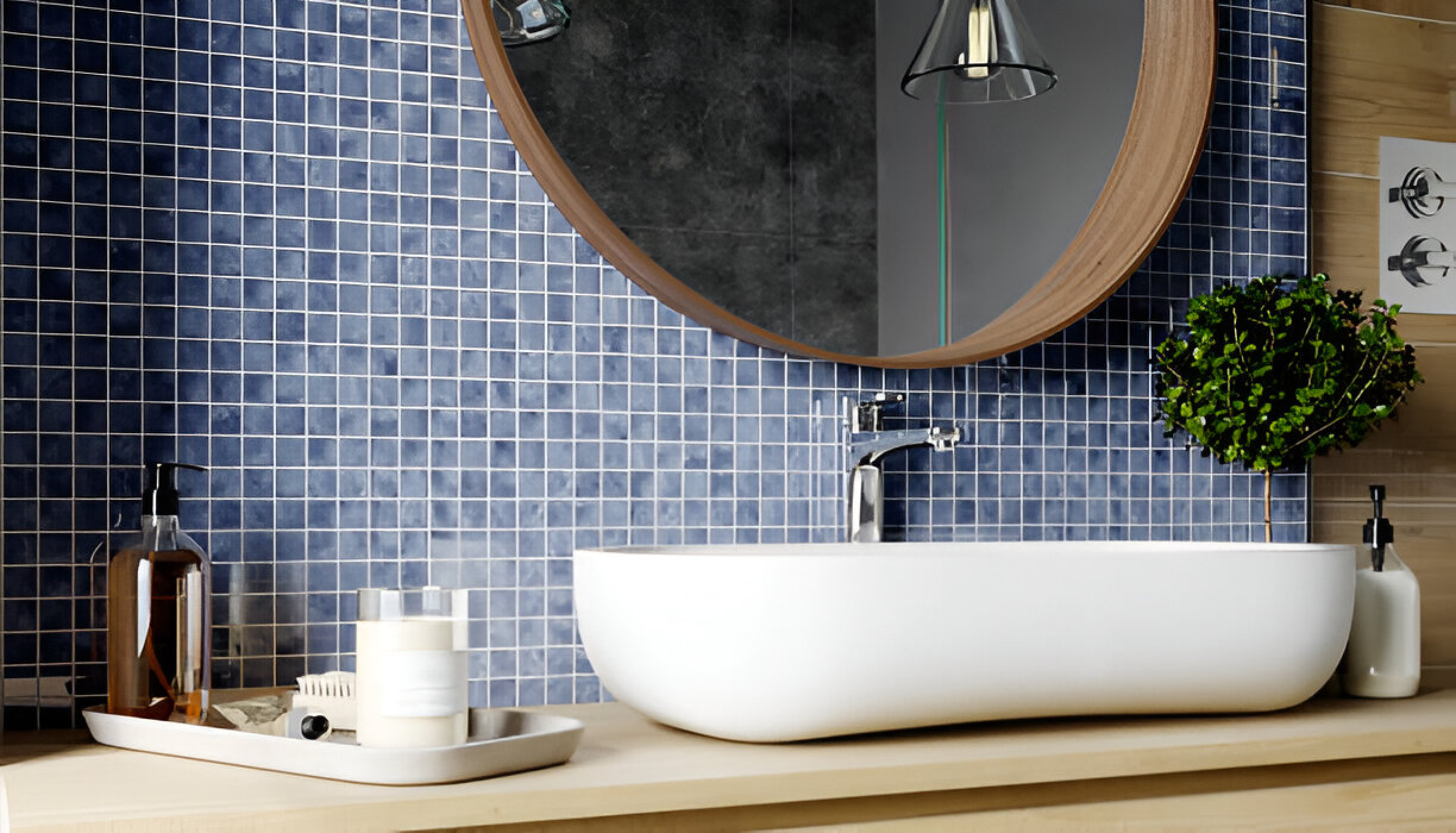How to Install Mosaic Tiles? A Comprehensive Step by Step Guide

Mosaic tiles bring emphasis to any space due to their intricate patterns and vibrant colors. This is easy to install as a do-it-yourself project, whether you want a backsplash in your kitchen or to add a beautiful mosaic wall art. That being said: it is not easy, of course you need good planning and execution. This complete guide will take you through a step-by-step process of mosaic tiles installation, starting from the choice of materials till the grouting and sealing. Read this guide to make a beautiful mosaic tile house.
What Are Mosaic Tiles?
Mosaic tiles are typically formed of small pieces of glass, ceramic, stone or porcelain that are fitted together to form a pattern or picture. Sold mounted on sheets of mesh or paper backing for quick installation. Mosaic tiles material come in a comprehensive range of colors, shapes and finishes are available to be mixed and matched for intricate or plain uniform designs. One can use these tiles as mosaic floor tiles, and backsplash as well.
Determining the Best Mosaic Tiles as Per Your Requirement
In order to start your project, you should select the perfect mosaic tiles. Common factors to consider are:
- These tiles range in different sizes, from tiny tesserae to large squares. Select an appropriate size according to the scale of your project.
- These tiles can be produced of glass, ceramic and stone, also as metal or perhaps recycled components. Every material has its own nature, and each work in usage for a different firmness or means.
- One needs to choose a repeatable color palette based on the pattern you are focusing on.
- Mosaic tiles also come in glossy, matte, or textured finishes. Think about the look you would like in your space.
- You can now check the budget before getting mosaic tiles. The price would typically depend on the material, size, and brand.
Materials Needed to Install Mosaic Tiles
Get all of your tools and supplies ready to go before starting the install. Here’s what you’ll need:
- Mosaic tiles (sheet or individual tile)
- Thinset mortar or tile mastic (the adhesive)
- Type of grout (non-sanded for small grout joints… you can use sanded but it is harder to push into tiny grout lines.
- 1/8 in or 1/4 inch notched trowel
- Tile spacers (if necessary)
- Tile cutter or nippers
- Grout float
- Sponge
- Bucket of water
- Painter’s tape (optional)
- Level
- Measuring tape
- Utility knife
- Sealant (Stone and other porous Tiles)
How to Install Mosaic Tiles Step by Step
Next you will need to follow the instructions showing how to install these materials to begin!
Step 1: Prepare the Surface
The initial and the most essential procedure in installing mosaic tiles material is to make certain that the surface where you are tiling is clean, flat, and most essentially dry. This makes the adhesive adhere well and can give you a scratchy-free, professional looking painting.
Cleanse the location where you are going to place the mosaic tiles(location is wall or floor ), wiping off all residue, dusty part, any dirt and moisture.
Check the surface with a level to make sure that it is even. Sand down any high spots and use a leveling compound to fill in any low spots to make sure you end up with a flat surface.
Leveling out can put water in your shower Get everything dry: It is not appropriate to keep a wet surface when applying adhesive.
Step 2: Plan the Layout
If you are installing mosaic floor tiles, then you must plan the layout. You cannot create a perfect mosaic design if the layout of your mosaic tiles are not well planned and properly placed at least in a symmetrical manner. While mosaic tiles usually come in sheets, if you have an intricate pattern planned for your floors or walls, get ready to measure and cut!
The first thing should be to measure the floor tiles area using a measuring tape. Identifying the middle of the wall or floor allows you to spread out your tiles evenly.
Put down your mosaic tile mesh sheet front on the price so you can visualize how they will appear before getting away and do any wanted changes. Patterns or design elements should match across the ranks.
If you have to cut mosaic tile sheets in order to fit them around corners or outlets, edges, use a tile cutter or nippers. A tile cutter is your best option for straight cuts and nippers will work for curved or irregular cuts.
Step 3: Apply the Adhesive
Now that the area is prepped and you have an idea what you are working with, it is time for the adhesive. Most mosaic tile sheets should be mounted with thin-set mortar, particularly in wet areas.
Prepare the adhesive according to manufacturer instructions. It should be the consistency of a soft peanut butter.
Using a notched trowel, spread the adhesive on sections of the surface, beginning from either center or bottom. Create ridges in the adhesive by holding the trowel at a 45-degree angle(ray plate to grass ridge) so that the tiles grip.
Do not spread too much glue. Spread adhesive only on the area that you can tile within 15-20 minutes. As the adhesive dries it will no longer be able to properly adhere to the tiles.
Step 4: Install the Mosaic Tiles
Simply stick the adhesive on at this point, and start laying the tile sheets.
Place the tiles into the adhesive: Slowly lower your first mosaic tile sheet into the adhesive and press it down slightly to help them adhere. By using a grout float, you can press flat the tiles to keep them level.
To prevent uneven or wonky tiles, be sure to check for alignment with a level. Gently use your fingers to adjust any minor imperfections in the tiles.
If your mosaic tiles don’t already come pre-spaced, use small tile spacers between the sheets and ensure uniform grout lines.
Move section by section: Keep applying adhesive and laying the mosaic tile sheets one by one each time moving further. Keep the tile in line and spaced accordingly as you go.
Step 5: Let the Adhesive Sit
Once all the tiles are installed, let the adhesive set for about 24 hours (or follow the time suggested by the adhesive manufacturer). Do not step or disturb the tiles in between.
Step 6: Apply Grout
After the glue should have dried then grout the tiles. The grout spaces are filled with grout so moisture will not cause the small mosaic tiles to fall out.
Read and follow the manufacturer instructions properly at this step. Mosaic tiles often are grouted using unsanded grout -good for lines up to 1/8 inch.
Take your grout float and holding at a slight angle, spread the grout over top of all of the tiles diagonally, pressing into all spaces in between each tile. Fill the gaps properly.
Wipe off excess grout: When you have the grout on evenly, take an edge of your grout float and scrape off any grout that is heaped over on the tops of the tiles.
Grouting Tips:
- Select a grout that is Appropriate for Mosaic Tiles: Utilize an excellent grout and make certain it matches the shade and finish.
- Too much grout looks unsightly and is difficult to use when cleaning tiles.
- Clean the grout lines If you like even more grout to evaporate than usual, it will make the job easier.
Step 7: Clean the Tiles
Once you have placed the grout be sure to clean any residual on top of the mosaic tiles as soon as possible before it hardens.
To remove grout haze from the tiles, scrub the surfaces down with a damp sponge. Regularly cleanse the sponge with warm, soapy water.
After the grout dries (usually after 24–48 hours) clean with a dry cloth to make the surface shine and remove any haze.
Step 8: If You Choose to Oil Your Tiles
If you have a porous mosaic floor tile, like natural stone or unglazed ceramic, you need to seal the surface with a tile sealant to protect it from water damage and staining. Reseal as recommended by the manufacturer, and reapply sealer every several years for continued protection. Taking care of the tiles with a good sealant will keep them safe from any spills, moisture or heavy use. Always choose a sealant that is appropriate for the material used in the mosaic tiles and how you plan to use it. Wait for the sealant to fully dry before using the surface. Put on several coats of sealant, giving time to completely dry between each one.
The Importance of Mosaic Tile Maintenance after Installation
Maintenance is needed in common areas where mosaic tiles material are installed. They can also be used for high-traffic areas as well as water surfaces such as kitchen and bathroom and swimming pool area etc. These tiny tiles have many grout lines and can easily become dirty, moldy, and grimy if you do not keep up with them. Failure to regularly clean and maintain mosaic tiles will consequently result in discolored, lifeless surfaces that are damaged.
1. Cleaning Mosaic Tiles Regularly
Your mosaic tile will stay stronger for longer the more you clean it. Kitchen backsplashes often accumulate grease and food splatters that need more frequent cleaning (perhaps daily), whereas mosaic floors or walls in a bathroom might only need weekly maintenance.
2. Clean at least once a day or week
Sweep or vacuum frequently: You can get rid of dust, dirt and debris from the surface of your mosaic tiles. Sweeping or vacuuming with a soft brush attachment will eliminate debris from getting stuck within the grout lines. Mosaic floor tiles catch dust quickly hence maintenance is very important.
For regular cleaning, mix warm water with a mild or neutral pH detergent. Avoid using harsh detergents or strong acidic cleaners as they can burn the glazed surface of the tile and spoil its finish.
Wipe with a soft cloth or sponge – wipe the tiles systematically and carefully to avoid smudges. Use a microfiber cloth and polish glass mosaic tiles.
After cleaning with detergent, rinse the tiles thoroughly with clean water to get rid of any soapy residue which can leave dullness on the surface later.
If your marble mosaic tiles cover a large area of the kitchen floor, consider using a microfiber or sponge mop. The mop should always be wet and never soaking to ensure that the water does not seep into the grout causing possible damage.
3. How to Get Stains Out of Mosaic Tiles
Mosaic tile is a beautiful way to spruce up any kitchen or bathroom, but mosaics seem permanent and difficult to remove. These tiles can become stained easily over time as they are in areas that are exposed to food, soap and other substances that will leave deposits over time so it is inevitable that you may need to replace the tiles at some stage.
Use a 50/50 vinegar-and-water solution to gently dissolve soap scum, hard water deposits or streaks on glass or ceramic mosaic tiles. Dip a sponge in this solution and use it to wipe the floor, leave it for some time and then rinse with plenty of water.
If the vinegar solution is not able to dislodge all of the built up stain, you can try mixing baking soda and water to form a paste and gently brush (or wipe if the fabric is super delicate) it on the stained area. Do not use steel wool or other abrasives that will scratch your tiles.
Glass or ceramic is highly nonporous when compared to other materials, such as marble or travertine, which can be easily stained as a result of their porous nature. Never use vinegar for an acidic cleaner on natural stone; it will cause etching.
Clean with a pH neutral stone cleaner: For stains on your natural stone mosaic, choose a stone-specific pH-neutral formula. Moreover, these cleaners do not cause harm to this surface and they gently lift the stains.
Stone poultice for severe stains: If a stain is more serious, you can create a stone poultice (part cleaning powder and part liquid solvent) that will draw out the stain from deep inside the stone. This breaks down and loosens the stain over a period of time. Read the manufacturer’s instructions for proper use.
4. Maintaining the Grout
Mosaic tiles tend to pull the color of dirt into grout, and dismal unmanaged grout lines often result in a tired looking mosaic floor. Due to the numerous grout lines, these tiles can collect dirt and become susceptible to mold and mildew formation if not effectively cared for.
Clean with a Grout Cleaner: Clean the grout regularly with a mild grout cleaner or even a mixture of baking soda and water in order to maintain its beauty. Scrub the grout lines carefully with a soft brush or toothbrush, taking care not to damage the surrounding tiles.
Hydrogen peroxide on stains: If you have discolored grout, this hydrogen peroxide combined with baking soda should do the trick. Allow to stand for a few minutes, then scrub with a soft brush and flush with water.
5. Avoiding Mold and Mildew Build-up in Moist Areas
These areas (your bathrooms — we know the struggle) see a lot of moisture, and so it can be difficult to maintain the grout with mold and mildew continually trying to come back to life. Make sure to keep the area well ventilated and after using the shower or taking a bath, dry the mosaic tiles by rubbing/using lint-free cloth.
Apply anti-mold solution: You can use an anti-mold solution, or you can clean the areas with a mixture of water and vinegar, which will prevent mold in the grout lines.
Conclusion
These are the step by step installation guidance for a mosaic tile house. Thus, you can decor your home with mosaic tiles. Be it mosaic tile backsplash, or for the floor, the installation process will be similar. However, you need to be very careful when you are tiling mosaic tiles.
FAQs
1. Can I install mosaic tiles as a DIY project?
Mosaic tiles being a nature friendly choice also make for excellent DIY project materials to install. But, it takes some time & attention to detail. If you are having doubts, hire an experienced installer.
2. What type of adhesive should I use for mosaic tiles?
A high quality tile adhesive designed only for fixing ceramic or glass tiles Apply according to manufacturer suggestions.
3. How long should I wait before grouting the mosaic tiles?
Wait until adhesive has cured fully per bottle/manufacturer before grouting. This generally can take 24-48 hours.
4. Can I use mosaic tiles outdoors?
Mosaic tiles can be used outside but you will need grout that is resistant to frost and a tiler fix.LivreMouseListener fix. Moreover, one might think about choosing mosaic tiles in connection with the climate and how much this area is exposed to natural influence.
5. How do I clean mosaic tiles?
Use a mixture of mild detergent solution and apply with a brush for cleaning mosaic tiles. Do not use harsh chemicals or abrasive cleaners.
6. Can I reuse mosaic tiles?
If you are getting rid of mosaic tiles they can sometimes be salvaged to use again in the future. But some it may not remove in good shape may damage it.
7. What tools do I need to install mosaic tiles?
To install mosaic tiles, you’ll require a leeway of devices including notched spreader, tile cutter-or- nipper if glass, grout float, sponge and sealer
8. How long does it take to install mosaic tiles?
Installation of the mosaic tiles may vary as it is depending on the DIY level that is selected and the size of project at hand. Scaling from a few hours of work for a small project, all the way up to several days/postings.
9. Can I mix different types of mosaic tiles?
The best bit is you can mix different types of mosaic tiles together for a totally unique and bespoke design.
10. How to choose the right grout color for mosaic tiles?
Choose a grout color that matches the color of your mosaic tiles. Offset the grout color with a bold statement or use a grout color to match and create sleekness.


